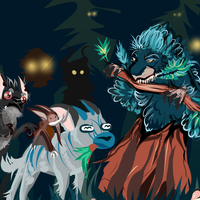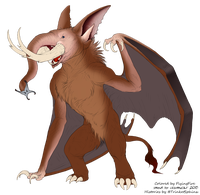Profile
I only own this species of elephant bat (Megaderma Spasma) for use.
The Manğaĵo at a Glance
Description:
All Manğaĵo have large ears, a prehensile trunk with grasping tendrils, back legs much more stout than any traditional bat species, a thin tail with a furred tuft, and two jagged tusks. This particular species fur and wings resembles the Lesser False Vampire Bat, (Megaderma spasma), species of bat; found in the same area.
Habitat:
Like any creature that employs mimicry as a main source of defense, Manğaĵo have evolved over centuries to stay in the same habitats as the species of bat they are mimicking.
Diet:
The Manğaĵo is a strict carnivore; on very rare occasions, they can be observed eating insects.
Feeding Behavior:
The Manğaĵo has a specialized sac for storing plant toxin behind their tusks, and it is deployed when pressure is applied to the tusks. They harvest this toxin by crushing up the poisonous plant known as Oleander in their mouths, and over time, the toxin in the sac becomes distilled into a much more potent form. Even creatures normally immune to the toxin have been observed to be affected by the bite of the Manğaĵo.
Nesting:
To protect itself and its young, the Manğaĵo uses the plant matter of Oleander mixed with its saliva to construct its nest. These nests can almost always be found in very dark crevices in nature. Usually in small pockets in rock formations, but they can sometimes be found in the hollows of dead trees. All Mangajo are capable of building their own nest, however, during the initial weeks of the first pregnancy of a pair, the two parents will work together to build a new home for them and their young.
Young:
Manğaĵo have bisexual reproduction and give live birth, like any other mammal. They have an average gestation of roughly 3 months, have 1 pup per pregnancy, (though twins can sometimes happen), and have only one breeding period in any given year. They typically stay in small family groups, until the territory they control starts to feel a little small, then the eldest pup will fly off to find a mate and start a new colony. They are fully mature by their first birthday.

